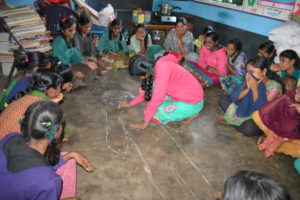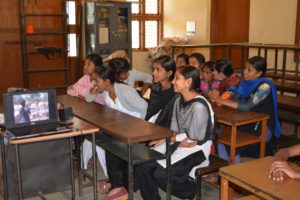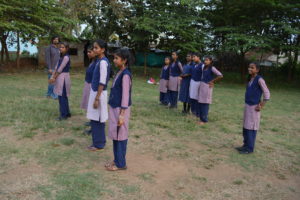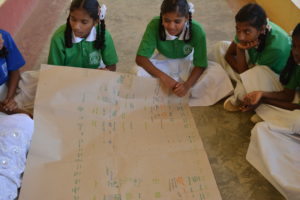In problem-posing education, people develop their power to perceive critically the way they exist in the world with which and in which they find themselves; they come to see the world not as a static reality, but as a reality in process, in transformation1
– Paulo Freire
At Prakriye, the pedagogy was inspired by Paulo Freire ‘s philosophy of the critical education for empowerment and social change. Subsequently, the focus is on learning through reflections and dialogues. In the second phase of Dhwanigalu, the curriculum was updated drawing from lessons learned from the first phase. The team also incorporated some learning resources created by the students of the SRISHTI school of Art, Design and Technology in 2016 in to the session plan. Even though the participants shared some common characteristics, there were cultural differences as well, especially in the tribal area. Subsequently, the session content and content delivery were altered in each locality to be context appropriate and meet the needs of the students. Thus, the pedagogy has been flexible and continuously evolving.
Understanding Gender Roles
Understanding Gender Roles was the very first module transacted after the orientation session. Here, the facilitator and the students discussed their understanding of sex, gender, the difference between the two and the gender roles practised in the society.
A body mapping activity was conducted to explain the changes that occur in the body during adolescence. Initially, the girls were very hesitant to draw the body map. They were also shy to name certain body parts. However, after the encouragement from the staff, they began to participate and label the body parts and changes in the picture. They became more comfortable discussing these topics as session progressed.

Women’s’ empowerment requires freeing the imagination of women and girls enabling them to dream beyond traditionally prescribed gender roles in the patriarchal society. With the aim of deconstructing these roles, the team facilitated a discussion with the girls regarding the work undertaken by men and women in the village. Most of the girls expressed the belief that that women will not be able to engage in labour-intensive activities such as driving, chopping firewood, tilling, ploughing or lifting large stones/rocks for construction of the buildings.
The team took note of this and screened the short film Namma akkandira nodi (Look at our Sisters). This Kannada film was produced by the Prakriye team and it featured the Mahila Samakhya Members from nearby villages engaging in ploughing, chopping firewood, driving a bullock cart and using computers. It was a deliberate choice to screen videos featuring women from the neighbouring localities so that the girls will find it easy to visualise and relate with the examples. The participants were quite enraptured by the film and the screening led to a lively discussion. Interestingly, after watching the film, girls were able to recollect women from the neighbouring areas who engaged in similar ‘masculine’ activities. They had previously regarded these women as anomalies and had not given much thought to such examples.
Some girls were still sceptical about women’s capacity to do labour-intensive tasks while some others felt that it is the social norms that are restricting them. Towards the end, after an intense debate, they reached the conclusion that women are capable of doing any work as long as they are determined enough. A girl from Jakkahalli quipped that now they have come to realise that ‘Manasu Iddalle Marga’ (where there is a will there is a way).

A power game was also played as part of the module. This activity was aimed at making the girls realise the structured oppression and marginalisation, women experience in a patriarchal society. In this activity, the students were divided into two groups and one group was asked to role-play as boys. They were asked a series of questions and asked to take one step forward if their answer to that query was affirmative. The questions were related to food distribution at home, mobility, access to higher education, access to public spaces, autonomy over choice of dressing, decision-making power and freedom to choose a life partner. The game started with both groups standing parallel to each other. However, by the time game ended, the group who role-played as boys were far ahead of the girls group.

The girls were taken aback by the gap that appeared between ‘girls’ and ‘boys’. While they were aware of the existing inequalities, the power game and the subsequent discussion, enabled them to see the gender based discrimination in its totality and made them realise that it is deeply embedded in social structure. This realisation that ‘personal is political’ is very much necessary for the formation of a political consciousness and feminist solidarity. The girls also admitted to feeling disturbed by the difference and expressed a desire to ‘move forward in the line’ as in improving the status quo.
-
“Invisible labour’ by women
In most societies, the unpaid work that women do is de-legitimised and not valued as ‘real work’ and this is particularly true in India (Javalgekar, 2017; Kohli and Das, 2017)2. Also, disproportionate burden of domestic work prevents women from entering the job market. In this context, the team wanted the girls to critically examine the gender division of labour at their homes and in the larger society.
The girls were asked to list the work done by men and women in the village and comment on that. They were of the opinion that women spent less time working compared to men who went out and worked. However, when they were asked to list the work undertaken by their father and mother respectively during daytime, they found that women spent more time working than men. The question of the value of the women’s labour also arose during the discussion. When the question of who does more work was taken up again, some girls opined that even though women undertake more work, they mostly undertake sedentary work while men engage in more productive work.
To deconstruct this, girls were asked to breakdown the tasks performed by each parent. For example, a student credited her father with the income they generated from selling the milk. The facilitator, with her help, broke down the process to small tasks and the students realised that her mother contributed more time and labour by taking care of the cow and milking it while father undertook the single activity of delivering the milk to local diary. She realised she had unconsciously credited him with the whole work as he was the one bringing money back from the diary. Many of them had never considered this angle before. During the discussion, Rakshitha from Kattamanahalli observed that thought of helping her mother in her chores had never occurred to her as work seemed like ‘real’ only when her father did it. Also, when they listed the daily routine, they came back with realisations like “My brother doesn’t have to do anything, but I have to do everything”.

To help in better comprehending this ‘invisible labour’ of women, girls were trained to take photos using digital camera and create digital stories on gender division of labour and their everyday activities. This was an activity carried over from phase one. Photographing men and women at work subsequently screening and analysing the DSTs, contributed to them developing a greater appreciation for the work done by women.
Sexual and Reproductive Health (SRH) education
Sexual and reproductive health education of the adolescents is severely neglected in India. Sex education is not included in the formal schooling curriculum and there is a stigma associated with discussion of such topics in public and private sphere. This leaves the adolescents with no safe spaces where they can obtain accurate and adequate information regarding their bodies and sexuality. While phase one curriculum included a small session related to Body Mapping, Prakriye decided to include more sessions on sexual and reproductive health education in the second phase training for select villages owing to the local requirements.
With this in mind, the team facilitated discussions about love, affection, sex and the difference between the three. Similar to the reaction to the body mapping exercise, initially girls were hesitant to open up owing to the ‘taboo’ attached to these topics. However, when the facilitator began to narrate her experiences, the girls also joined the discussion and shared their perspectives and experiences. The team also screened the short film ‘Komal’ 3on child sexual abuse that teaches children about safe and unsafe touch and also how to protect themselves from sexual abuse.